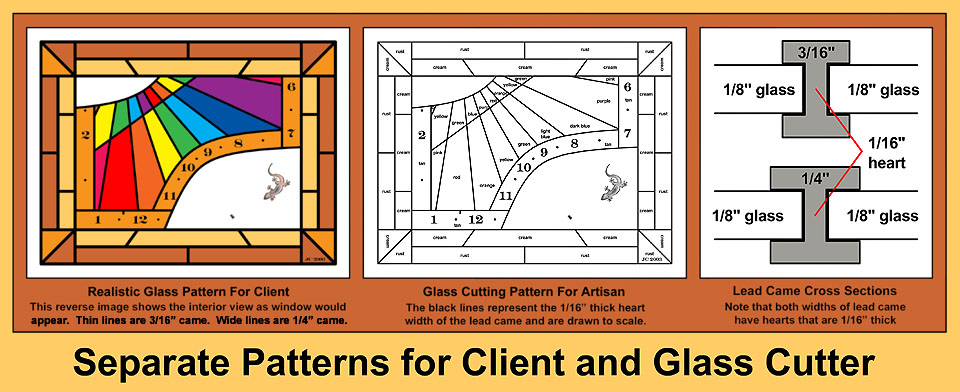

Designing a stained glass sundial window pattern requires collaboration between the client, the glass artisan and the sundial designer. Today's stained glass craftsmen can build a sundial window almost as easily as a typical stained glass window if they have a little technical help with their sundial drawings. Astronomical laws demand that every sundial have a different design depending on its location. Window sundials will function as accurate timepieces only if a qualified sundial designer who understands the math involved provides the artisan with a custom-made design based on the window's specific location using its latitude and longitude. Most sundial designers now use special computer programs to calculate and draw ultra precise sundial designs that are available in printed or digital form. Using this sundial design, the glass artisan can make a window that is just a sundial or he can embellish the sundial design with extra artwork. By looking at photos of existing glass sundials, and using your imagination, you can visualize that many different stained glass sundial designs of all shapes and sizes, from traditional to modern are possible. To see a PDF drawing of many sundial shape options, click Here:
The client, glass artisan and sundial designer must discuss details such as the sundial's latitude and longitude, size, shape and position on the window, gnomon type and time notation (Standard Time or Daylight Saving Time). Do you want the sundial to tell the date too? With this information the sundial designer can produce an accurate sundial drawing of the sundial face and gnomon that the glass artisan can work into a final window pattern. The artisan should have little trouble incorporating a drawing of a sundial into a beautiful working sundial window. Or the full-service designer can make a complete and finalized pattern of the whole window that the artisan can just copy.
Sundial designers calculate and draw the design of a window sundial just as they would design a typical exterior wall sundial using the same mathematics and their favorite computer programs. But then they need to reverse the image, text and numerals on the sundial face drawing to account for the fact that the sundial is meant to be viewed primarily from inside the building and not from the outside. Most glass artisans assemble windows using interior patterns but some may prefer to have an exterior drawing pattern in which case, the numerals and letters will still need to be reversed to be readable from the interior.
The glass artisan needs a full-scale pattern that looks like and is often called a cartoon. The black lines on the pattern drawing show the actual width of the metal came heart or copper foil unions that separate the edges of the glass pieces. This line width is 1/16" (1.6mm) for metal cames, or 1/32" (.08 mm) for copper foil unions. Most CAD drawing programs allow you to specify line width or if you are drawing your pattern by hand, then a Sharpee Fine Point marker draws a line that's about 1/16th inch thick. The pattern is usually in black and white and each piece of glass is labeled with the glass type and the direction of the "grain" in the glass. You need two identical copies. One copy is cut into glass-shaped pieces and is glued to the stock glass pane as a cutting and grinding guide. The other copy is taped to the wood assembly board as a glass and came assembly guide. You can make the patterns on paper, velum or Mylar. Since both patterns get wet during glass grinding and sizing, paper patterns can become distorted from the humidity. Mylar will hold up better than paper and can be reused for duplicate glass pieces.
You or the client might also want a different pattern that shows an interior view of the window as it would actually look after final assembly with the actual width of the lead came, and the colors of the glass. The glass cartoon pattern will have thinner lines than the client's pattern.
 |
Avoid using in your window pattern narrow pieces of glass that are longer than 12 inches (30cm) because they are weak and might crack.
|